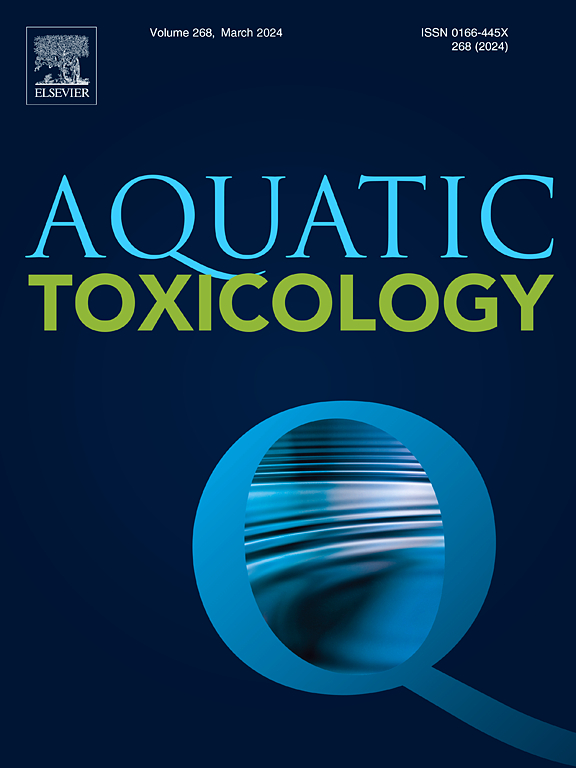Impact of copper nanoparticles (CuNPs) on gonadal development in zebrafish larvae and melatonin therapeutic intervention
IF 4.3
2区 环境科学与生态学
Q1 MARINE & FRESHWATER BIOLOGY
引用次数: 0
Abstract
Copper nanoparticles (CuNPs), owing to their high specific surface area and reactivity, are extensively applied across various fields while concurrently posing certain hazards to aquatic organisms. This study comprehensively investigated the detrimental effects of CuNPs on the reproductive system of zebrafish and emphasized the examination of the potential therapeutic role of melatonin. The research found that CuNPs interfere with zebrafish gonadal development through oxidative damage, endocrine disruption (upregulated estradiol, E2; downregulated testosterone, T), and suppression of reproduction-related genes, consequently causing impaired germ cell development and even organismal mortality. Through transcriptomic research, we discovered that CuNPs induce gonadal oxidative stress (Oxidative phosphorylation pathway) and endoplasmic reticulum stress (Protein processing in endoplasmic reticulum pathway), downregulate zgc:153,993 to activate the mitochondrial apoptosis pathway, and inhibit the hsp70l-MAPK/ERK feedback loop to amplify damage; the organism compensatorily upregulated cyp2x12 to enhance detoxification function and upregulated dync1i1/dync1li2 to activate the Phagosome pathway to clear aberrant apoptotic products. Melatonin, by antagonizing ROS and repairing stress-induced damage, modulated the expression of most key gonadal development genes to restore homeostasis. Simultaneously, it transcriptionally upregulated ribosome biogenesis gene (si:dkey-103j14.5) and lysosomal pathway gene (si:ch211–122f10.4) to alleviate nucleic acid oxidation damage and clear damaged substrates. Finally, by upregulating got2a to activate the aspartate metabolism pathway, it achieved multi-target therapeutic intervention against gonadal injury under CuNPs exposure. Our study reveals the physiological and molecular mechanisms underlying the reproductive toxicity of CuNPs; melatonin, as an endogenous protective agent, shows promise in mitigating the ecotoxicological effects of CuNPs.
铜纳米粒子(CuNPs)对斑马鱼幼体性腺发育的影响及褪黑素治疗干预
铜纳米颗粒由于其高比表面积和反应性,被广泛应用于各个领域,同时也对水生生物造成一定的危害。本研究全面研究了CuNPs对斑马鱼生殖系统的有害影响,并强调了褪黑素的潜在治疗作用。研究发现,CuNPs通过氧化损伤、内分泌干扰(上调雌二醇、E2;下调睾丸激素(T),抑制生殖相关基因,从而导致生殖细胞发育受损,甚至机体死亡。通过转录组学研究,我们发现CuNPs诱导性腺氧化应激(氧化磷酸化途径)和内质网应激(内质网蛋白加工途径),下调zgc:153993激活线粒体凋亡途径,抑制hsp70l-MAPK/ERK反馈回路,放大损伤;机体代偿性上调cyp2 × 12以增强解毒功能,上调dync1i1/dync1li2以激活吞噬体途径清除异常凋亡产物。褪黑素通过拮抗活性氧和修复应激引起的损伤,调节大多数关键性腺发育基因的表达,以恢复体内平衡。同时,通过转录上调核糖体生物发生基因(si:dkey-103j14.5)和溶酶体途径基因(si:ch211-122f10.4),减轻核酸氧化损伤,清除受损底物。最后,通过上调got2a激活天冬氨酸代谢通路,实现对CuNPs暴露下性腺损伤的多靶点治疗干预。我们的研究揭示了CuNPs生殖毒性的生理和分子机制;褪黑素作为一种内源性保护剂,在缓解CuNPs的生态毒理学效应方面显示出良好的前景。
本文章由计算机程序翻译,如有差异,请以英文原文为准。
求助全文
约1分钟内获得全文
求助全文
来源期刊

Aquatic Toxicology
环境科学-毒理学
CiteScore
7.10
自引率
4.40%
发文量
250
审稿时长
56 days
期刊介绍:
Aquatic Toxicology publishes significant contributions that increase the understanding of the impact of harmful substances (including natural and synthetic chemicals) on aquatic organisms and ecosystems.
Aquatic Toxicology considers both laboratory and field studies with a focus on marine/ freshwater environments. We strive to attract high quality original scientific papers, critical reviews and expert opinion papers in the following areas: Effects of harmful substances on molecular, cellular, sub-organismal, organismal, population, community, and ecosystem level; Toxic Mechanisms; Genetic disturbances, transgenerational effects, behavioral and adaptive responses; Impacts of harmful substances on structure, function of and services provided by aquatic ecosystems; Mixture toxicity assessment; Statistical approaches to predict exposure to and hazards of contaminants
The journal also considers manuscripts in other areas, such as the development of innovative concepts, approaches, and methodologies, which promote the wider application of toxicological datasets to the protection of aquatic environments and inform ecological risk assessments and decision making by relevant authorities.
 求助内容:
求助内容: 应助结果提醒方式:
应助结果提醒方式:


